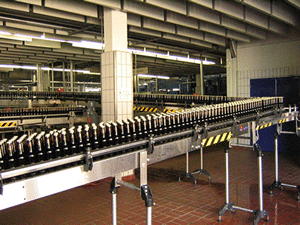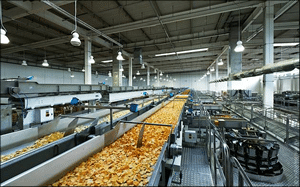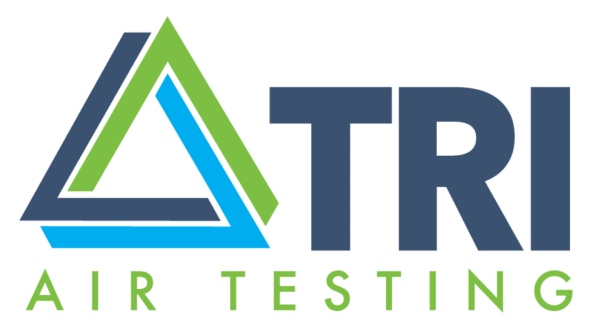High-quality compressed air is critical for providing food products that are not only cost effective to process but safe to eat.
Compressed air is a universally accepted power distribution method in industry. The food manufacturing and processing industry uses compressed air in multiple operations. Compressed air provides the energy for pneumatic conveyers that transport liquids and powders. Compressed air also provides power for pneumatically operated tools and equipment that process meat products, aerate liquids and mix granular ingredients. It is ultimately used in processes that package, wrap, seal, label and palletize food products prior to storage or shipment.
 The food products in all of these process operations have a wide range of susceptibility to their surroundings including the air quality that the compressed air has helped to determine. Some of products are moisture sensitive and others may be sensitive to odors that may impart smell or taste from compressed airborne oils, particulates and hydrocarbon gases. It is critical to determine what constitutes good compressed air quality to maintain food that is both safe for consumer health and food with the proper sensory experience to that ultimate end user. Once these quality indicators have been determined, the challenge is to always ensure that level of quality during the manufacturing and processing operations. Identifying and measurement of key quality indicators is required. Armed with this information and supporting data you will be able to meet all the required FDA-enforced cGMP and other production safety issues for both your product and compliance to regulatory requirements.
The food products in all of these process operations have a wide range of susceptibility to their surroundings including the air quality that the compressed air has helped to determine. Some of products are moisture sensitive and others may be sensitive to odors that may impart smell or taste from compressed airborne oils, particulates and hydrocarbon gases. It is critical to determine what constitutes good compressed air quality to maintain food that is both safe for consumer health and food with the proper sensory experience to that ultimate end user. Once these quality indicators have been determined, the challenge is to always ensure that level of quality during the manufacturing and processing operations. Identifying and measurement of key quality indicators is required. Armed with this information and supporting data you will be able to meet all the required FDA-enforced cGMP and other production safety issues for both your product and compliance to regulatory requirements.
(DEW) POINT OF CONTACT
 A critical point of safety in food preparation and distribution is the management of moisture.
A critical point of safety in food preparation and distribution is the management of moisture.
A full understanding of compressed air is essential to the safe management of air dew points in food preparation facilities, particularly in regards to the many potential production points at which compressed air comes in contact with food products. Refrigerated systems are used to cool compressed air for the removal of water. The humidity must be tightly controlled to inhibit the growth of bacteria and other micro-organisms. There isn’t a one-temperature-fits-all solution, however. Some products may be destroyed by -50°F pressure dew point air. That air could desiccate the food product. For other products, this extremely dry air may be necessary for safety.
Finding the point at which product safety is maximized without adversely and unnecessarily decreasing the overall facility’s energy efficiency and employee breathing air safety requires testing the compressed air regularly to ensure the compressed air quality being used is consistent and appropriate for the life cycle success of the food products being prepped, prepared and packaged.
The quality standards of the independent laboratory you use for your compressed air testing is vital to ensuring that the efforts your facility dedicates to achieving safe air best practices (for personnel and product health) are optimized.
TRI has developed guidelines for direct and indirect product contact to assist facilities in fine-tuning their compress air operations. For indirect product contact, you will generally have to go below 0°F which requires a refrigerated drying system. For direct product contact, at least -40°F and likely -50°F dew points will be necessary for product safety, which requires a desiccant drying system.
Again, no “hard and fast” rule can be applied, save for in regards to OSHA breathing air standards for employee safety.
Food preparation and handling facilities, like pharmaceutical facilities, must develop a careful understanding of their products and testing protocol to ensure the compressed air that is vital to their operations is used consistently and responsibly.
FINE-TUNING OPERATIONS
 An interesting aspect in the management of compressed air is that the compressor itself is less of a concern. The air compressor industry is a mature one, and the products are highly engineered. How those compressors are used, however, is the concern. The moisture and particulate matter must be properly managed in the compressed air—another reason that compressed air testing has become so important. Contaminants to test for include oil, particulate, moisture, and mold/bacteria. Reaching acceptable levels for safe operations may require the utilization of point-of-use filters. This way, the more stringent quality requirements of a critical operation can be met without the expense of maintaining this level of quality where it isn’t needed.
An interesting aspect in the management of compressed air is that the compressor itself is less of a concern. The air compressor industry is a mature one, and the products are highly engineered. How those compressors are used, however, is the concern. The moisture and particulate matter must be properly managed in the compressed air—another reason that compressed air testing has become so important. Contaminants to test for include oil, particulate, moisture, and mold/bacteria. Reaching acceptable levels for safe operations may require the utilization of point-of-use filters. This way, the more stringent quality requirements of a critical operation can be met without the expense of maintaining this level of quality where it isn’t needed.
Another parameter often overlooked is volatile hydrocarbons. These are material that could impart odor and taste. While not necessarily a health concern, they could result in a very negative experience for the end user.
Plant engineers may also need to create a facility- or application-specific standard, one that brings together the specific needs of the facility with existing compressed air quality specs, such as ISO 8573 (Class 1 and Class 2), USP, OSHA, FDA and cGMP.
Again, at TRI we break down this understanding into two categories: Direct Product Contact and Indirect Product Contact. For the food preparation and packaging industries, it provides a good point from which to start the discussion and evaluation of compressed air as it relates to product and personnel safety.
A general guidance document can be downloaded here.
TRI Air Testing provides independent laboratory support for many food and beverage companies and offers 24-hour turnaround time and online access to testing reports. Plant engineers throughout the United States use testing equipment and media provided by TRI to collect compressed air samples as part of their facilities’ air quality compliance, safety and energy efficiency assurance measures.





